Health, Holloway and Hype Part 1
Thomas Holloway: The Marketing Giant
Fortune and Legacy

Thomas Holloway was born in Devonport in Devon on 22 September 1800. A self-made man with an eye for marketing, Holloway amassed a great fortune, valued at his death at nearly £40 million in today’s money, not including a considerable amount of property. After leaving school, Thomas helped his father run a pub and assisted his mother in a grocer’s shop. Ambitious and aware of the limitations in Cornwall, where the family had now settled, he left home in 1828. He spent several years in northern France and, on his return, secured employment as a secretary and French interpreter at a London firm of importers and exporters, before setting up his own agency in 1836. It was here, in 1837, that he met the ointment salesman Felix Albinolo.
Inspired, Holloway began producing his own Universal Family Ointment, and advertisements appeared in The Sunday Times and other newspapers as early as October 1837. Sales of his ointment were disappointing to begin with and so, in 1839, he began manufacturing pills using a hand-operated machine. Soon, he moved to larger premises in The Strand, London, and in January 1840 married Jane Driver who joined her husband in working long hours to help grow the business.
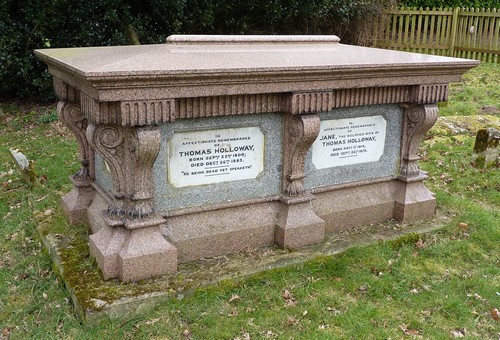
Jane died in 1875 and Thomas died on 26 December 1883, before either his namesake College and Sanatorium had been built and completed.
Marketing his Products
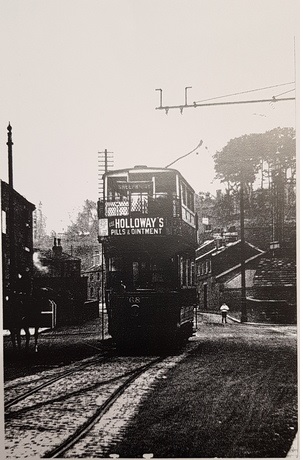
Holloway’s genius lay not in the curative treatment of his pills and ointments, but in his grasp of modern advertising. ‘Holloway’s Pills and Ointments’ were one of the first truly global brands, with Thomas’s advertising budget at £1,000 in 1838, rising to £30,000 in 1855, and up to a staggering £50,000 in 1883 (approximately £3,310,000 in today’s money). In addition to his newspaper advertisements, Holloway’s pills and ointments were promoted on the sides of trams, through collectible cards and on trade tokens. Hoardings showing his adverts even appeared at Niagara Falls and the foot of the Great Pyramids at Giza.
There were many different groups of collectible cards which had various subject matters – from sets such as animals and nature, illustrations of songs and rhymes, to sports and pastimes. Many newspaper adverts showed people, mainly ladies, from places across the world such as China, India and Constantinople, all using Holloway products with positive results. An 1880 advert in Spencers’ Illustrated Leicester Almanack notes that “Full Printed directions are affixed to each Pot and Box, and can be had in any language, even in Turkish, Arabic, Armenian, Persian, or Chinese.” Whilst an American advert ends by stating the product is sold “by most Vendors of Medicine throughout the civilised world”.
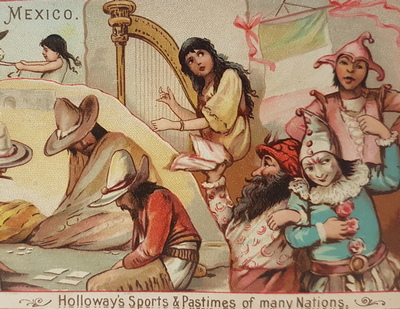
Symbolism is often used in the marketing, such as the inclusion of a snake drinking from a bowl. The snake is commonly associated with medicine, derived from the Greek God Asclepius who had a snake twined round his staff. The bowl is also a symbol, coming from the bowl of Hygeia, Greek Goddess of Hygiene. Often in Holloway’s adverts, a child in a classical-style toga is seen holding a sign saying ‘Never Despair’, which was Holloway’s motto.

The pills and ointment business continued after Holloway’s death, and was managed by Jane’s brother-in-law, George Martin. It ran until 1930 when Holloway’s Pills Ltd, of Chipstone Street, London, W1, was taken over by Beecham’s.
Advice and Testimonials
Although the pills themselves were of little medical value, they would cause their recipients no harm. Made from non-toxic ingredients such as cinnamon, ginger and saffron, they would mostly act as a diuretic. Despite this, Holloway stated his pills and ointments would cure all ailments, from liver and stomach disorders, to bad legs and piles. Common to his advertisements were extraordinary claims and glowing testimonials. One such testimonial from Mrs. A. Stafford of Bristol, stated: “I have found great benefit by taking Holloway’s Pills. I was always a sufferer from Indigestion, but they have made a different woman of me.” Another supporter writes: “I have cured bites of venomous insects, rheumatism, chest and throat complaints. The Ointment is a sovereign cure for Cuts and Bruises.”
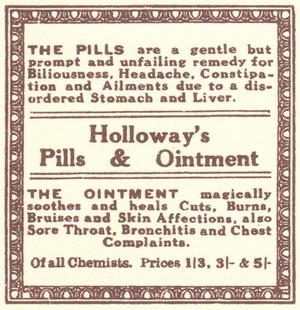
For a short time, Holloway used the title of ‘Professor’ in his advertising, even though he was not qualified. He often provided medical advice in his marketing and shared his own authoritative ‘medical’ philosophy in various guides. One such guide was the ‘Medical Guide for the use of missionaries and others who kindly interest themselves in recommending the use of his remedies’ published in 1878, which states: “It has been my aim in succeeding pages to offer a few such simple and practical directions for the preservation and restoration of health…”. [1]
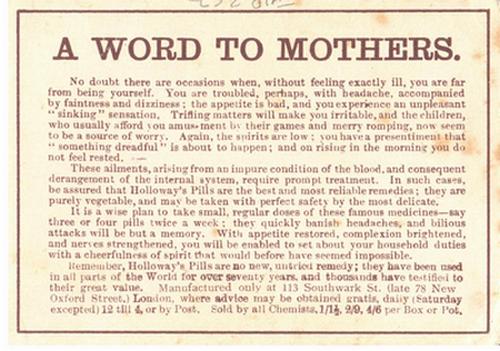
Holloway was not without his critics and was often classed as a “quack”, along with contemporaries such as C. and G. Kearsley who manufactured Widow Welch’s Female Pills and the makers of Dr William’s Pink Pills. Holloway’s Universal Ointment was referenced in an 1855 edition of Punch Magazine where the article’s author mockingly stated: “it will mend the legs of men and tables equally well and will be found an excellent article for frying fish in.” [2] It is thought a reference is also aimed at Holloway in Gilbert and Sullivan’s ʻThe Mikadoʼ (written 1884–1885, first performed March 1885). When the Mikado is listing punishments to fit various crimes, he sings:
The advertising quack who wearies
With tales of countless cures,
His teeth, I’ve enacted,
Shall all be extracted
By terrified amateurs.
Read Part 2 here
Our ‘Health, Holloway and Hype’ exhibition was proudly funded by the Royal Holloway, University of London, Citizens Project, supported by the National Lottery Heritage Fund.
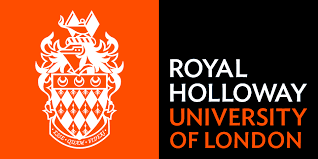
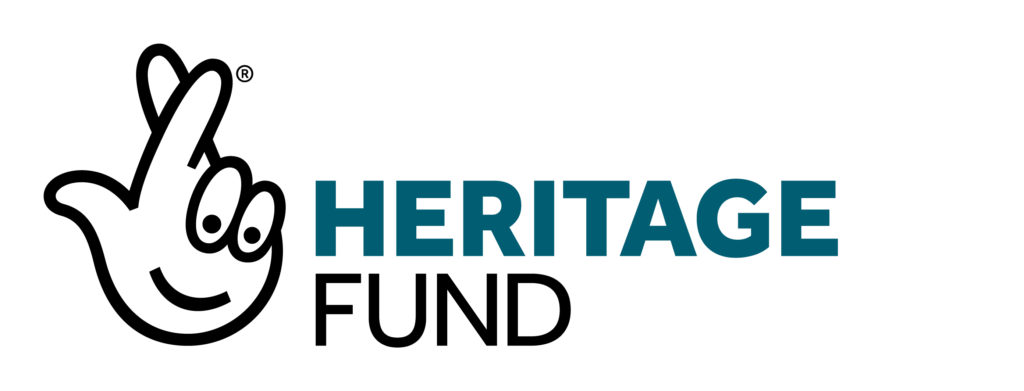
References
1. Harrison-Barbet, A. (1993, rev) Thomas Holloway, Victorian Philanthropist, pp.64-65.
2. Corley, T.A.B. (2011) Beechams, 1848–2000. From pills to pharmaceuticals (Crucible Books), p.32.
Holloway, V. (2016) The Mighty Healer: Thomas Holloway’s Victorian patent medicine empire (Pen & Sword History).

